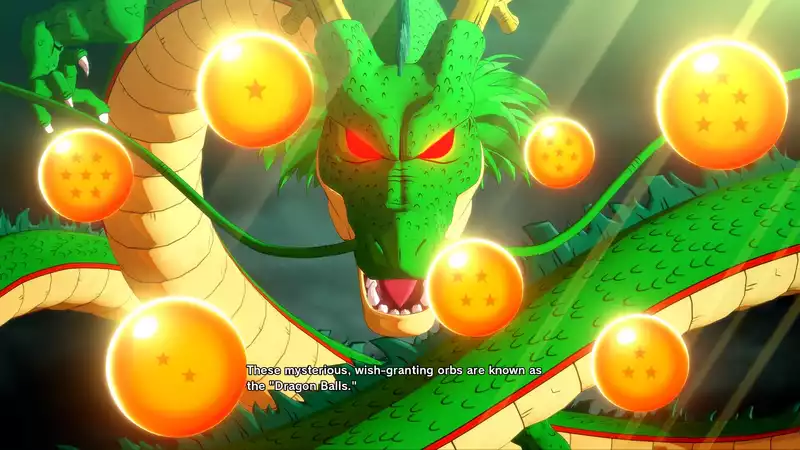When the Dragon Ball Z anime first aired, the first arc ran for 39 episodes. Assuming each episode lasted approximately 22 minutes (not including commercials), it was approximately 14.5 hours until Vegeta was defeated. In "Dragon Ball Z: Kai," this was shortened to 26 episodes, for a total viewing time of 9.5 hours.
In "Dragon Ball Z: Kakarot," this first arc, including all sub-stories, can be completed in about 6 hours. The year spent in training is sped up, and you can see bits and pieces of Gohan's transformation and Goku's training in the afterlife without having to forcibly defeat X number of creatures. As a game, "Kakarot" understands what you are here for. It's a larger than life, planet-destroying battle, with RPG elements thrown in to give you a sense of growth and progress.
"Dragon Ball Z Kakarot" covers four major arcs - Saiyan, Frieza, Cell, and Buu - but manages to cut even more waste than "Kai." As a result, all the major parts of the story are covered, but you don't have to watch the battles, which take many episodes. Instead, the battles fight themselves.
Battles are similar to those in Dragon Ball Xenoverse, but slightly simplified. The system requires you to start with basic ki attacks and punches. Then, when given the chance, powerful techniques are unleashed.
The battles feel epic, but are ultimately very simple. You approach, perform basic combos, and then follow up with special moves. Most battles can be completed without problems, although recovery items are sometimes needed. Battles make you feel that you are a surprisingly strong Z warrior, but can lack tension.
To avoid easy combos, the game gives the bosses counterattacks and sometimes armor. If you try to score a combo in close combat, the enemy will stop being stunned and suddenly counterattack.
Kakarot allows you to explore the open world and collect different things, but you are never forced to run around and do anything other than the next main storyline. If you want to, you can spend hours fishing, gathering materials, or flying around collecting Z orbs. But if you don't want to do that, you can just go ahead and come back later. Kakarot's side quests, sub-stories, seem to expire after a certain amount of time, but you can return to various time periods after completing the game.
This freedom is one of Kakarot's strengths. The main characters often gain a lot of experience as part of the storyline, so that they are not underpowered in the battles ahead. In addition, many of the training tasks in Turtle School can be completed just by dutifully doing them, and you will also have enough recovery items to get through the tough story battles. You don't have to work hard, you don't have to worry about finding the ingredients to make the perfect meal, and you don't have to complete all the sub-stories. The option to do it all is there if you want.
However, there are some systems that can feel like a burden. The community boards are Kakarot's biggest draw, but the benefits of collecting and leveling up soul emblems are not at all worth the effort. Considering that the main purpose of doing the sub-stories is to obtain additional soul emblems, the motivation to do anything other than the main storyline is gone.
There are skills to level up, but sometimes training is required before spending orbs in the skill tree. Meals can have both permanent and temporary effects, but you can also ask Chichi to cook you a full-course meal if you can find a recipe. Turtle School assignments need to be submitted to Master Roshi, but not often in the middle of the story. Collecting dragon balls later seems cool and in keeping with the show's theme, but in the end, the reward is not worth the effort.
It's enough to be a burden, especially if you're just trying to complete basic tasks. I had forgotten for a while that there was a skill tree to level up, since the early tutorial takes care of everything. It was then that I decided to find out what to do with the Z orbs I picked up, hidden under some menus. There is so much going on under the hood of Kakarot that it is all too easy not to understand everything the game throws at you.
As for performance, Kakarot played well on my rig. When I first started the game, there was a lot of screen tearing during movie cutscenes, but once I turned on V-sync, the problem went away. Other than a slight drop in FPS when flying around the overworld map, the game was pretty smooth. There were no noticeable slowdowns during combat, which is most important for a solid FPS, and overall the game played quite well.
"Dragon Ball Z Kakarot" is by no means perfect, but it is a solid RPG that covers the entire "Dragon Ball Z" saga very efficiently. While the game itself can fall apart under the weight of its own system, "Kakarot" is still a fun way to revisit (or experience for the first time) the Dragon Ball Z saga.
.

Comments